Gardeners Art Through the Ages Since 1300 a Global History Salvador Dai
"Just I don't desire to become amidst mad people," Alice remarked.
"Oh, yous tin can't assistance that," said the Cat: "nosotros're all mad here. I'm mad. You're mad."
"How do yous know I'm mad?" said Alice.
"You must be," said the Cat, or you wouldn't have come here."—Lewis Carroll,Alice in Wonderland

Hieronymus Bosch, The Garden of Earthly Delights, c. 1480-1505, oil on console, 220 x 390 cm (Prado, Madrid)
Deciphering the indecipherable
To write about Hieronymus Bosch'south triptych, known to the mod age asThe Garden of Earthly Delights, is to effort to describe the indescribable and to decipher the indecipherable—an do in madness. Nonetheless, there are a few points that can be made with certainty before information technology all unravels.
The painting was offset described in 1517 past the Italian chronicler Antonio de Beatis, who saw it in the palace of the counts of Nassau in Brussels. Information technology can therefore exist considered a commissioned work. The fact that the counts were powerful political players in the Burgundian Netherlands made the palace a stage for important diplomatic receptions and the work must have caused something of a sensation with its viewing audience, since information technology was copied, both in painting and tapestry, afterward Bosch's death in 1516.

Hieronymus Bosch, The Garden of Earthly Delights (outer panels), c. 1480-1505, oil on panel, 220 x 390 cm (Prado, Madrid)
We can assume, therefore, that Bosch's bizarre dictionary of man congress must accept held some appeal, or some meaning, for a gimmicky audience. In a period marked past religious decline in Europe and, in the Netherlands, the first chroma of capitalism post-obit the abolition of the guilds, the work has often been interpreted as an admonition against fleshly and worldly indulgence, but that seems a rather prosaic purpose to assign to a highly idiosyncratic and expressively detailed tour-de-strength. And, indeed, there is very little agreement as to the precise meaning of the work. It is a cosmos and damnation triptych, starting with Adam and Eve and ending with a highly imaginative through-the-looking drinking glass kind of Hell. No one really knows why Bosch imagined the globe in this particular way.
Here's what I think. What concerned Bosch, in his triptych of creation, human futility and damnation (the Garden of Earthly Delights is a modernistic misnomer for the piece of work), was the substantially comic ephemerality of human life. Permit me to explain.
The outer panels

God (detail of outer panels), Hieronymus Bosch, The Garden of Earthly Delights, c. 1480-1505, oil on panel, 220 x 390 cm (Prado)
When the triptych is in the closed position (above), the outer panels, painted in grisaille (monochrome), bring together to form a perfect sphere—a vision of a planet-shaped clear drinking glass vessel half-filled with h2o, interpreted to be either the depiction of the Alluvion, or day three of God's creation of the world (which has to do with the springing forth of flowers, plants and trees, in which case he'south guilty of daydreaming over-watering).
A tiny figure of God, property an open book, is found in the uppermost left corner of the left panel, and the inscription that runs along the superlative of both panels tin can exist translated to read "For he spoke, and it came to exist; he commanded, and it stood firm," which is from Psalm 33.nine. If one thinks of the exterior panels as the end of the entire pictorial cycle, rather than its beginning, then this image could easily be a depiction of the Flood, sent past God to cleanse the world after it was consumed past vice.
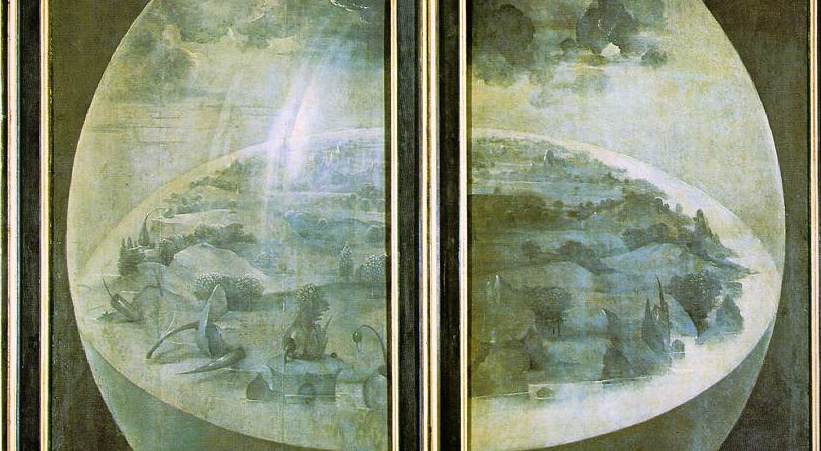
Outer panels (item), Hieronymus Bosch, The Garden of Earthly Delights, c. 1480-1505, oil on panel, 220 ten 390 cm (Prado)
This path towards vice is mapped in the inner panels of the triptych. The outer panels are therefore intended to provoke meditative purgation, a cleansing of the mind. It should be pointed out that this work, like Bosch'southward Hay Wain triptych (too framed by a cosmos and damnation scene), is a triptych only in form; neither depict the conventional arrangement of a tripartite altarpiece because their center panels do not include religious figures or even religious scenes. What Bosch seems to have invented is an entirely new class of secular triptych, 1 that functioned kind of like a Renaissance habitation theater package for wealthy patrons.
The get-go panel: God Introduces Eve to Adam (and all hell breaks loose)
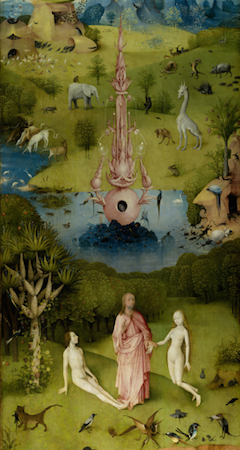
Particular, Hieronymus Bosch, The Garden of Earthly Delights, c. 1480-1505, oil on panel, 220 x 390 cm (Prado)
The first panel depicts God, looking like a mad scientist in a mural blithe by vaguely alchemical vials and beakers, presiding over the introduction of Eve to Adam (which, in itself, is a rather rare field of study). Although they are precisely located in the center foreground, in scale Adam and Eve—too as God—are precisely equally of import as the other creatures in this paradisiacal garden, including an elephant, a giraffe (direct out of Piero de' Cosimo) a unicorn and other more than hybrid and less recognizable animals, along with birds, fish, other aquatic creations, snakes and insects.
The introduction of woman to homo, in this setting, is conspicuously intended to highlight not just God's creativity but human procreative capacity. In the bureaucracy of God's handiwork, Adam and Eve correspond his most daring achievement, as though after he'd made everything else he idea he needed to leave a signature on the earth in which he could recognize himself. It's a matter of conjecture, when one gain to the key panel, as to whether Bosch is maxim that the creation of man, on whom God conferred free volition, might accept been a divine error.
The central panel: People nakedly cavort (and all hell breaks loose)
This is the panel from which the championship Garden of Earthly Delights was derived. Here Bosch'due south humans, the offspring of Adam and Eve, gambol freely in a surrealistic paradisiacal garden, appearing as mad manifestations of a whimsical creator—sensate cogs of nature alive in a larger, animate automobile. It is a matter of divided stance as to what, exactly, the humans are actually doing in this delightful, dense and nonsensical landscape, alive with a dizzying array of some of Bosch's nigh delectable creatures and dotted with his alembic architecture. It is almost as though he imagined the world of creation equally a terrific Willy Wonka series of machines with humans every bit their product.

Detail, Hieronymus Bosch, The Garden of Earthly Delights, c. 1480-1505, oil on panel, 220 x 390 cm (Prado)
Given Bosch's emphasis on nude figures, some of which are engaged in amorous activities —although none in flagrante—this key scene has often been interpreted as a warning against animalism, especially in conjunction with the third panel, depicting Hell (the Spanish Hapsburgs, in fact, referred to the work as "La Lujuria" — lust). I wonder though. Bosch'southward depiction of humans cavorting in the elemental globe of God's creation, seems, to me, less inculpatory than just a commentary on the fact that at that place's little to differentiate man from animals from plants.
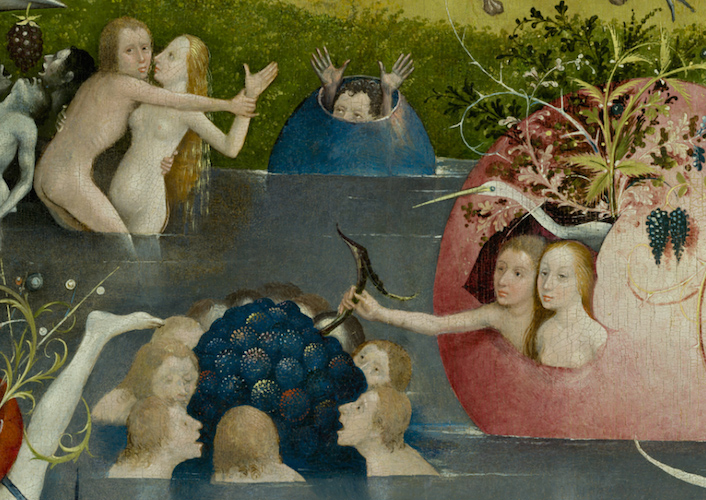
Central console (detail), Hieronymus Bosch, The Garden of Earthly Delights, c. 1480-1505, oil on panel, 220 10 390 cm (Prado)
Many figures announced in all sorts of chrysalis states, or inside eggs or shells, and are fed ripe berries by birds or strange hybrid creatures; in the middle-ground some kind of procession of men, riding on diverse animals and accompanied by birds, circles a small lake of bathing maidens. It's true that some unlikely human being orifices are blimp with flowers, just at that place is no explicit sex activity in this panel—merely a gluttonous consumption of varieties of berries that accept, by some, been linked to the pervasively hallucinogenic atmosphere (magic berries instead of magic mushrooms). In the stop, there is folly and in that location is much that is visceral, just in that location'due south no existent vice.
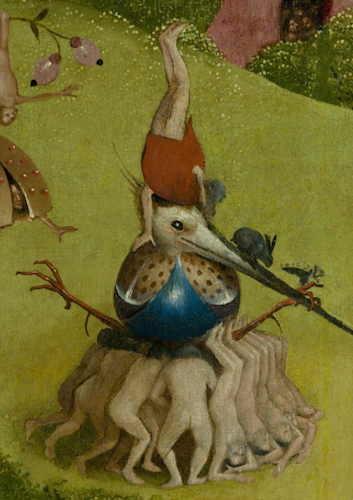
Particular, Hieronymus Bosch, The Garden of Earthly Delights, c. 1480-1505, oil on console, 220 x 390 cm (Prado)
Instead, what Bosch appears to be doing is contemplating man'south identify in the greater divine motorcar of nature. Mayhap he'due south saying, equally Lucretius did, that all matter is made of atoms that come together for a time to form a sensible thing and, when that thing dies, those atoms return to their origins to reconfigure in some other grade. This breaking and becoming is the nature of nature, and human in nature, is not differentiated past anything OTHER than his free will, his concern for his own beliefs. Our reason is our undoing. Every man'south hell is just what he can imagine, and Bosch was more imaginative than near. His was a highly singular and idiosyncratic talent, and Bosch was actually no more than a product of his own time than he would have been of whatever other time. However, his ability to visualize hallucinatory landscapes made him extremely popular, three centuries later, with surrealists similar Salvador Dali, who was also a virtuoso imagineer of nightmarish other-worldly worlds. I would venture to guess that Lewis Carroll must also have been a fan.
The third console: Finally, all hell breaks loose
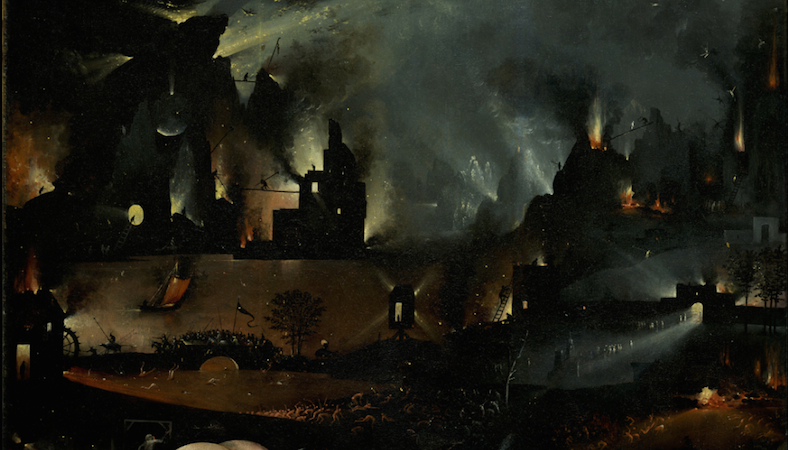
Console of hell (detail), Hieronymus Bosch, The Garden of Earthly Delights, c. 1480-1505, oil on console, 220 x 390 cm (Prado)
Bosch saves the best for last. Before visions of Hell, if indeed that'due south what Bosch intended here, are pretty tame in comparison to this. Against a backdrop of blackness, prison-similar urban center walls are etched in inky silhouette against areas of flame and everywhere human bodies huddle in groups, aggregate in armies or are subject to strange tortures at the hands of oddly-clad executioners and animal-demons.

Console of hell (particular), Hieronymus Bosch, The Garden of Earthly Delights, c. 1480-1505, oil on panel, 220 10 390 cm (Prado)
Dotted nearly are more than crazy machine-similar structures that seem designed to procedure human being flesh. Some of these are strikingly disturbing. Most the center, a bird-like creature seated in a latrine chair, like a male monarch on a throne, ingests humans and excretes them out again; nearby a wretched human being is encouraged to vomit into a well in which other human being faces swirl below the water.
In general, the bodies purge themselves or are purged of demons, black birds, vomitus fluids, blood; every bit in any proficient Boschian world, bottoms continue to exist prodded with various instruments. Simply the general emphasis is on purgation.
Overall, there is a marked emphasis on musical instruments as symbols of evil distraction, the siren call of self-indulgence, and the large ears, which scuttle along the ground although pierced with a knife, are a powerful allusion to the deceptive lure of the senses. In fact, many of the symbols and the tortures hither are pretty standard in the catalogue of the 7 Mortiferous Sins, in which our senses deceive our thoughts into self-indulgent over-consumption.
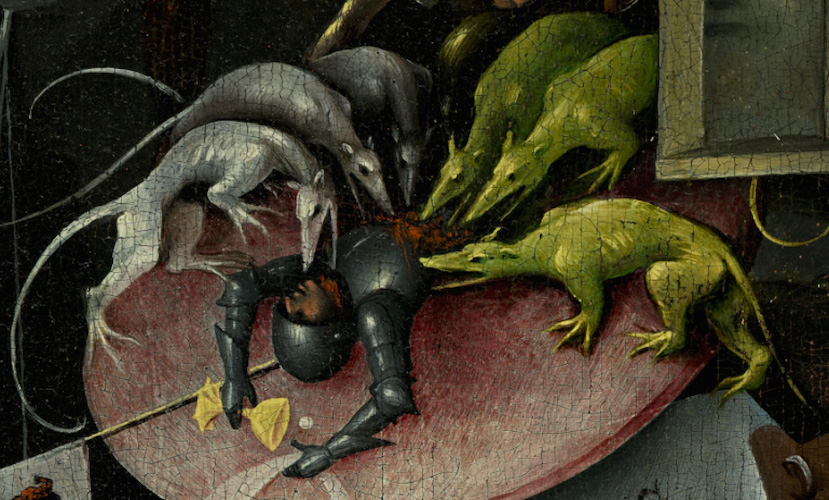
Panel of hell (item), Hieronymus Bosch, The Garden of Earthly Delights, c. 1480-1505, oil on panel, 220 10 390 cm (Prado)
One cardinal element here, however, requires some explication—the central, Humpty-Dumpty-ish figure who gazes out of the scene, his cracked-beat out body impaled on the limbs of a dead tree. The art historian Hans Belting thought this was a self-portrait of Bosch, and a lot of people believe this, but it's incommunicable to verify. Still, it quite strikingly illustrates the presence of a controlling, human consciousness in the middle of all this tortured imagining. And this is where my estimation parts ways with those who have come before.
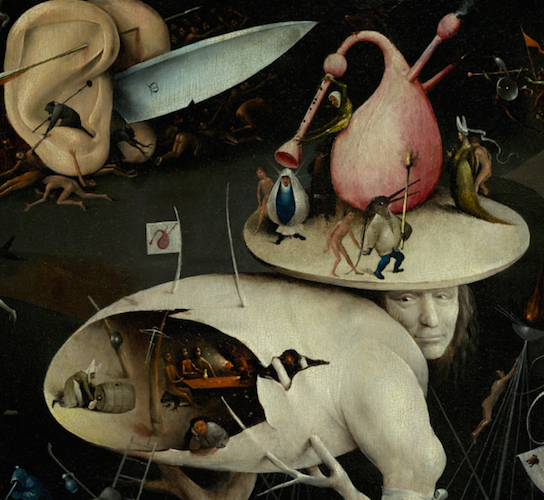
Panel of hell (detail), Hieronymus Bosch, The Garden of Earthly Delights, c. 1480-1505, oil on panel, 220 x 390 cm (Prado)

Detail, Hieronymus Bosch, The Garden of Earthly Delights, c. 1480-1505, oil on console, 220 x 390 cm (Prado)
Because, while "Bosch's" heed (if it is a self-portrait) might be distracted with thoughts of lust, symbolized past the bagpipe-similar instrument balanced on his head (standard phallic stand-in), within the hollow of his body, a tiny trio of figures sit at a tabular array as though dining. To me, these three figures are reminiscent of Genesis 18.2, in which God arrives at the door of Abraham, accompanied by two angels (all disguised as ordinary men) and Abraham, without question, offers them his humble hospitality. Equally his advantage, God bestows a miraculous pregnancy on the aged Abraham and Sarah, declaring that, through this act, Abraham will father God's chosen tribe on globe. This would also be consistent with Psalm 33.12: " Blest is the nation whose God is the LORD, the people he chose for his inheritance." God then sends his angels (who are kind of early incarnations of FBI agents) to investigate matters in Sodom and Gomorrah, and Abraham uses this opportunity to arbitrate with God on behalf of the wickedness of the people there: "Volition you sweep abroad the righteous with the wicked?" he asks.
It seems to me that this is the question the whole triptych asks—whether God, having made the world and having conferred on man both the blessing and the curse of costless will, would destroy all of his creation in the face of human failing. This is the cardinal connectedness between these inner panels and the destructive alluvion depicted on the outer wings. Bosch's lesson, if there is 1, seems to be that we can choose good over evil or we can be swept away. Man proposes, God disposes.
Source: https://smarthistory.org/bosch-the-garden-of-earthly-delights/
0 Response to "Gardeners Art Through the Ages Since 1300 a Global History Salvador Dai"
Post a Comment